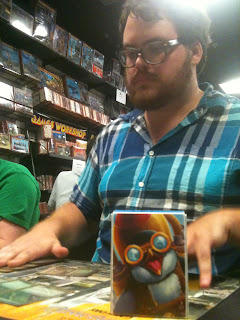The first deck we're going to look at is more favored in Europe than in the U.S., but it's still a powerhouse in the American metagame. Here are two things in life you can't avoid: Death and Taxes. This deck is basically a mono-White deck centered around Aether Vial that attacks its opponent's mana base while building a field an army of difficult-to-remove creatures. This deck creates incredible interactions that abuse Mangara of Corondor using both Flickerwisp and Karakas. This particular list is more aggressive than most, using maindeck Dismember and Mirran Crusader to push in a lot of damage that decks like Shardless B/U/G can rarely deal with.
Next, we'll look at the decks that started off very similarly to the Caw-Blade decks of Zendikar-Scars of Mirrodin Standard format, but have been refined and tuned into powerful decks in different ways. First off is the most recent Bant Stoneblade. This deck combines a lot of the power of Maverick, a G/W Aggro deck that uses a Green Sun's Zenith package to tutor up creatures that suppress the field while adding Blue for consistency and lite Counter backup. Blue also gives you access to Meddling Mage, which is a very powerful sideboard card and is starting to see a massive resurgence right now. I'm a fan of this list partly because I love both Knight of the Reliquary and Jace, the Mind Sculptor and both do very powerful things in this deck.
The next list we're looking at is similar in game plan and construction of traditional Stoneblade decks, but it completely foregoes Blue; this deck is named Team Italia. This deck gained momentum with the printing of Lingering Souls, since before the deck was confined to just Bitterblossom to ensure they would have creatures to go with their equipment. Instead of focusing on mana denial like Death and Taxes, this deck aggressively attacks its opponent's hand with Inquisition of Kozilek, Thoughtseize, Liliana of the Veil, and Tidehollow Sculler while using Dark Confidant to keep their hand filled with cards. The Red in this deck is purely just for removal such as Grim Lavamancer and Lightning Bolt. Even though Grim Lavamancer and Deathrite Shaman are a bit of a nombo together, both cards are powerful enough and different enough from each other to both see play here.
This next deck was format defining for over a year, even taking down a GP in the hands of Tom Martell. We're talking about the beast, Esper Stoneblade. This deck has experienced a ton of changes over the years and gained a powerful ally, Geist of Saint Traft. I consider this archetype to be the epitome of the Stoneblade variants with plenty of disruption, a powerful game plan, and a very versatile list of 75. This deck has been waning in popularity in the last few months as players get more greedy with its mana base and add more colors, giving way to Esper Deathblade, which plays arguably the most powerful one-drop in the format, Deathrite Shaman. The game plan of both these Stoneblade variants are very similar, but Deathblade lists have the added utility of its Green splash giving them access to Abrupt Decay to answer many problematic permanents Esper Stoneblade has difficulty answering. However, the Deathblade variant is more susceptible to mana denial, which is currently very popular.
American Delver varies from the majority of the Stoneblade variants because Stoneforge Mystic isn't the main plan. American Delver is a fairly stocked deck, but hasn't wandered from Stifle that saw play in earlier versions of the archetype. This deck also has a lot of methods to flip a Delver of Secrets on turn 2 which tends to end a lot of games quickly, but you also have the power of Stoneforge Mystic and Geist of Saint Traft in the mid to late game for reach. You also have access to repeatable removal in Grim Lavamancer which helps push in Batterskull tokens and Geist of Saint Traft.
Stoneforge Mystic has been a pillar of Legacy for years now, and is in all sorts of Aggro decks in the format. This little Squire is a true powerhouse and a card that's worth testing out if you're looking for a new deck to play or enter the Legacy format.
Check out the MTG Casual Net Archive and Like us on Facebook!
-John Wyly

.jpg)






























